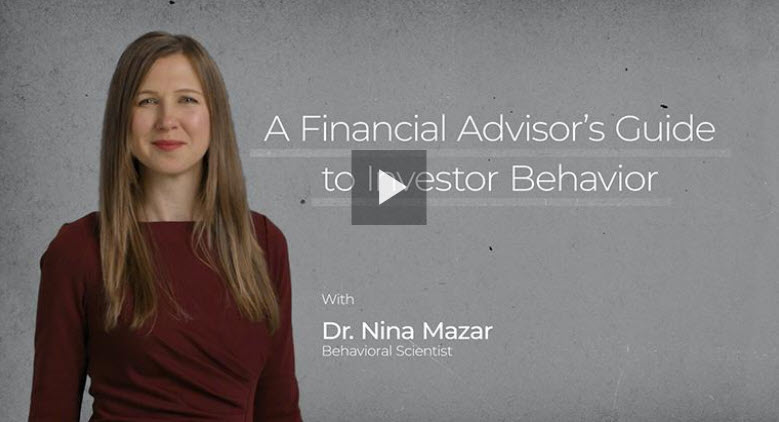- Our Blog
Download PDF
We tapped into the expertise of a behavioral scientist to examine the most common — and detrimental — investor behaviors. Here’s what professor Nina Mazar had to say.
How can financial advisors help investors override the natural biases that undermine their investment success? By helping them recognize the behavior that may be influencing their decisions.
Humans have developed great mechanisms to deal with some of the most complex situations and decisions imaginable. We have sent people to the moon, created ever smaller electronic devices that make up a huge part of our lives and mapped the human genome. Our brains themselves are powerful network systems unmatched in speed by the world’s largest supercomputers. In a recent simulation of a single second’s worth of activity from just 1% of the human brain, one of the world’s most powerful supercomputers needed 40 minutes to calculate.1
One of the reasons our brains are so powerful is that they often use shortcuts, so-called heuristics or rules of thumb. While heuristics serve us well most of the time, we now also know, thanks to academics working in the field of behavioral science (most prominently represented by Dan Ariely and Nobel Laureates Daniel Kahneman and Richard Thaler), that they can sometimes lead to systematic errors, so-called biases.
Advisor Resources
Educate your clients on investor behaviors and help protect them from their own biases with our collection of videos, client fliers and notes for advisors.
These biases affect all of our decision-making and they are hard to control because they predominantly happen unconsciously and automatically. Behavioral biases can be acutely consequential to a person’s quality of life when it comes to investment decisions.
These are some of the primary behavioral biases affecting investors:
-
Overconfidence: Most of us believe we are smarter, better looking or happier than the majority of people (but of course, we can’t all be above average). We also tend to have overly strong beliefs in the correctness of our information and judgements. Overconfidence is one of the most dangerous biases when it comes to investing and may contribute to excessive rates of trading in the stock market. It’s often coupled with confirmation bias — the tendency to seek out information that validates our existing beliefs. It can result in overly risky decisions and poorly diversified portfolios.
-
Loss aversion: For the human brain, losing something is twice as painful as the pleasure experienced from gaining the same thing. Loss aversion causes investors to overweight losses relative to gains and can result in them being overly fearful and risk-averse. It’s why investors may miss the next rally (due to the fear and pain lingering from the previous bear market) or can’t stomach to sell losers when the money could be channeled to higher quality investments.
-
Anchoring: Investors tend to rely too heavily on the most salient information, such as the last high or low price of a stock. Once that information is locked in the brain, it’s hard for an investor to adjust their opinion to recognize any new information. For example, investor A may find a stock price of $500 for company XYZ too expensive but investor B, who had initially bought the same stock for $1,000, may find $500 cheap. Even if investors have the same information, their valuations will likely differ depending on the anchors they focus on.
-
Pattern-seeking behavior: Finally, there’s pattern-seeking behavior: The human tendency to look for meaning and trends in even the most random patterns — and to take action on this faulty observation. Following good or bad streaks, for example, an investor may infer that a fund is above or below average and, in turn, predict a continuation of this performance.
A financial advisor can help: A skilled financial advisor, mindful of some of the pitfalls caused by behavioral biases, can play an important role in helping investors make better informed and more objective decisions. An advisor can curate information that helps investors think critically and keep their long-term focus. For example, an advisor can help investors preemptively set rules for what to do in future situations (e.g., set target prices or other thresholds), put those in writing and refer back to them as reminders when things get too heated. Another way to help is to encourage investors to actively seek out disconfirming or alternative information and to consider opportunity costs.
Bottom line
Ultimately, while there is no way to completely eliminate biases, a financial advisor can support investors to take steps to minimize those biases’ influence. By becoming aware of their natural impulses, investors can engage the reflective side of their brain and learn to stop undermining their own financial success.
Nina Mazar is a professor of behavioral science at Boston University and co-director of the Susilo Institute for Ethics in the Global Economy. She was formerly senior behavioral scientist for the World Bank’s Behavioral Insights Initiative. Website: http://NinaMazar.com

